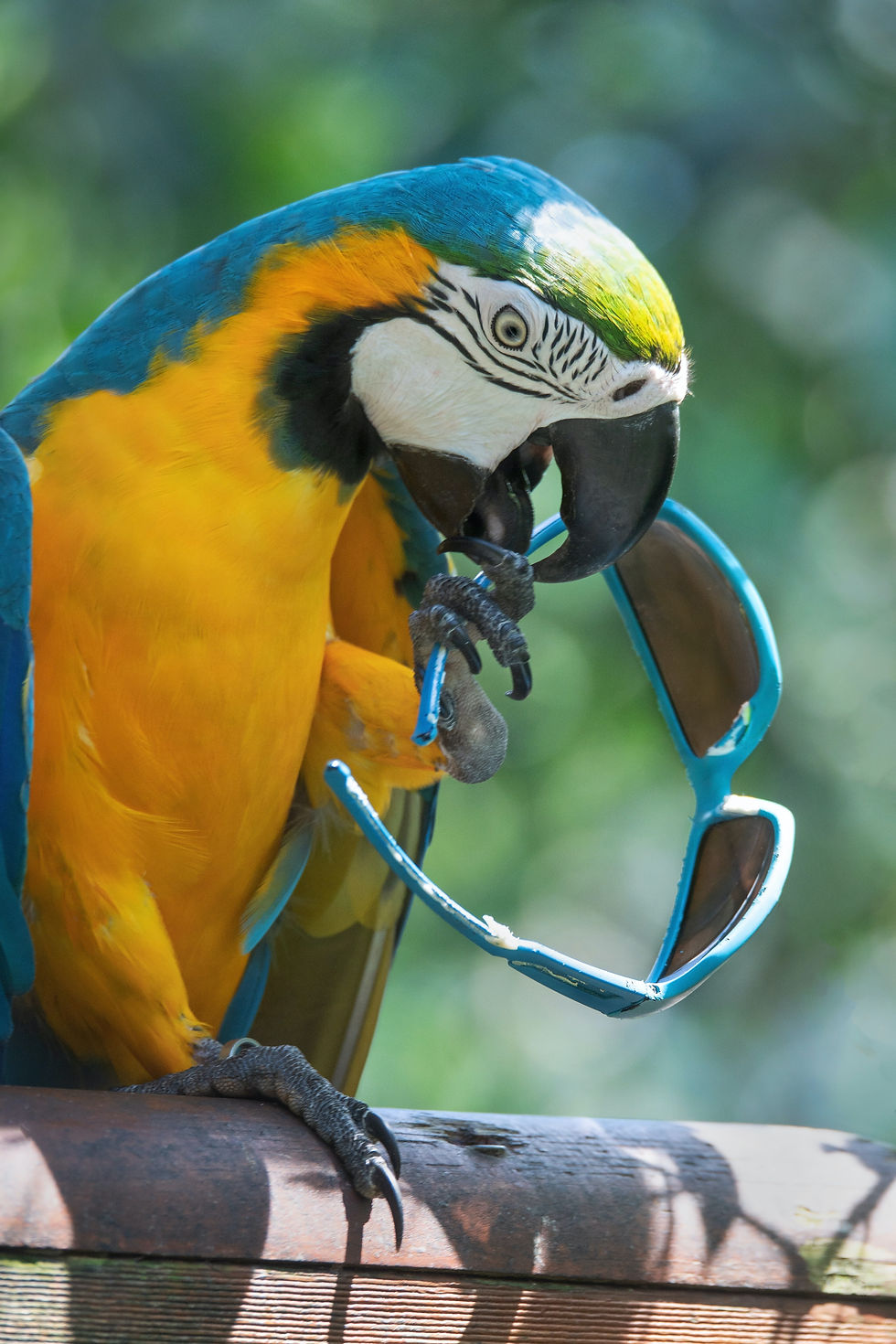The History of Parrots in Human Culture: From Sacred Symbols to Dying Species
- naturallycaptive
- Aug 7
- 3 min read

Parrots have been part of human life for thousands of years—not just as exotic pets, but as powerful symbols, treasured companions, and even political emblems. Their vibrant feathers, sharp intelligence, and uncanny ability to mimic speech have fascinated cultures around the globe. Let’s explore how parrots have made their mark on human history and how their early impression on history has ultimately led to their demise.
Ancient Civilizations and Sacred Symbols
Parrots held symbolic meaning in many ancient cultures:

Indigenous Tribes in South America: Tribes in the Amazon revered parrots and macaws for their beauty and association with the spirit world. Their feathers were used in ceremonial headdresses and clothing, symbolizing connection with nature.
Aztecs and Mayans: These Mesoamerican civilizations considered parrots sacred. Green feathers from quetzals and parrots were woven into royal garments and offered to gods.
India: In Hindu mythology, parrots are associated with the god of love, Kamadeva. The parrot, often green, is seen as a symbol of romance and desire, frequently depicted in ancient paintings and poetry.
Parrots and Pirates: A Colorful Legend
The classic image of a pirate with a parrot on his shoulder may be more literary than historical, but it’s rooted in truth. Seafarers during the Age of Exploration often returned from tropical regions with parrots, which were considered valuable, exotic pets in Europe.
Parrots were intelligent, relatively small, and could be trained to speak—making them the perfect conversation starters among wealthy patrons or seamen with long days at sea.
Parrots in Art and Literature

During the Renaissance, parrots were symbols of luxury and the exotic. European
paintings often included parrots as signs of wealth or as allegorical figures. In Christian art, parrots even appeared as symbols of the Virgin Mary due to the belief they could speak without sin.
Literature didn’t miss out either. From Shakespeare’s references to parrots mimicking speech to the classic parrot in Treasure Island, they’ve long been literary fixtures symbolizing wisdom, mystery, or mischief.
Royal Companions and Exotic Collectibles
Parrots were kept by nobility and royalty across Europe, Asia, and the Middle East:
Queen Isabella of Spain reportedly received a parrot from Columbus after his voyage to the Americas.
Emperor Heliogabalus of Rome had a fondness for parrots in his menagerie.
Exotic bird collections in the Victorian era often featured parrots as prized members.
Keeping parrots became a status symbol—a blend of wealth, worldliness, and eccentricity.
Parrots in the Digital Age
In more recent decades, parrots have become social media stars. Viral videos of dancing cockatoos, talking African Greys, and cuddly conures have made them more popular than ever.
While this visibility can raise awareness about how amazing these birds are, it also increases demand, which can unintentionally fuel black-market sales and impulse purchases by unprepared owners.
The Dark Legacy: Exploitation and Illegal Trade

Unfortunately, human and parrot interaction has cost them a lot. The very fascination that made parrots cultural icons has also pushed many species toward endangerment, and the beautiful landscapes that they call home are being wiped out.
Pet Trade: The global pet industry has driven demand for wild-caught parrots, resulting in the capture and smuggling of millions of birds, especially in the 20th century.
Feather Trade: For centuries, indigenous and colonial cultures harvested parrot feathers for fashion and ceremonial use—some sustainably, but others destructively.
Habitat Destruction: Many parrot species are native to tropical and subtropical forests, which are being cleared at alarming rates for agriculture, logging, mining, and urban development. This destruction doesn’t just reduce the number of trees—it removes essential nesting sites, food sources, and safe roosting areas.
Today, the illegal wildlife trade continues to threaten species like the African Grey Parrot, Yellow-Naped Amazon, and Hyacinth Macaw.
Many of these birds suffer during transit, and few survive the journey from the forest to the cage. There are also generations of parrots in countries far from their native lands, packed into cages and given the bare minimum to survive and bred repeatedly to supply the ever demanding pet parrot market.
While some countries have enacted bans and conservation measures, illegal poaching persists—driven largely by this ongoing demand.
Final Thoughts
Parrots have lived beside humans for millennia—as sacred symbols, status icons, companions, and entertainers.
But their beauty and intelligence have also led to widespread exploitation, habitat loss, and declining wild populations.
As modern caretakers, it’s up to us to appreciate parrots ethically, support conservation efforts, and educate others about the dangers of illegal trade. Admiring parrots is easy—protecting them takes effort, but it’s the only way to ensure they continue to thrive in both the wild and our shared cultural story.




Comments